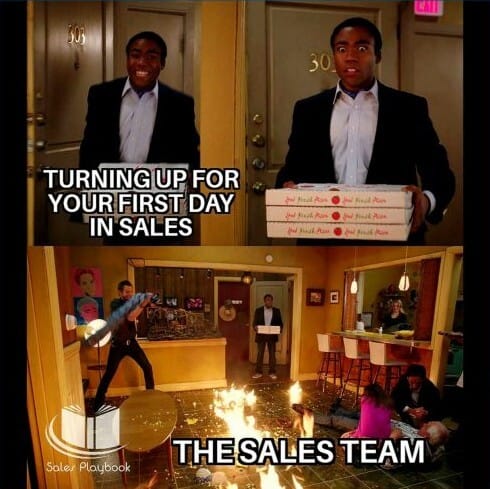- SalesDaily Newsletter
- Posts
- 🧱 overcome pushbacks
🧱 overcome pushbacks
Polite “maybes” are quietly killing your deals
Daily Sales Newsletter October 08, 2025 |
|
Welcome - this is your daily dose of sharp, tactical sales advice.
To access all my premium resources, please upgrade to Premium.
In today’s issue:
Ian Koniak: Transform conversations into buying decisions
Armand Farrokh: “We already have a vendor…”
Krysten Conner: How to stay in control when buyers delay
Kevin Dorsey: Identify polite maybes with these questions
Upgrade to Premium
Access exclusive SalesDaily resources on strategic pushback techniques.
For example, these NL issues:
Plus, these additional resources:
 Access to The AI Sales Mastery Program |
Transform conversations into buying decisions
Ian Koniak explains why “maybes” are your silent deal killers.
Every deal should move forward or get cleared out. Don’t chase possibilities.
1. Maybes are your silent killers
📌 Deals labeled as “maybe” distract you from potential active buyers.
Example: If a buyer keeps saying “checking internally” for weeks, that’s paralysis.
✔ If it’s not moving, it’s dying. Treat maybes as no until proven otherwise.
2. Momentum is everything
📌 Deals move fastest when next steps are confirmed immediately.
Example: When a discovery call ends, say:
“Let’s schedule the demo now while calendars are open.”
✔ Control momentum in the moment - or lose your chance forever.
3. Commitment is the real close
📌 Top sellers don’t focus on signatures, they focus on micro-yeses.
Example: “If we build the business case, can you bring in your CFO next week?”
✔ Every yes, no matter how small, compounds into a signed deal.
4. Sales is a two-way street
📌 If the buyers refuse information access, walk away confidently.
Example: “I’ll need input from finance and operations. Can we make that happen?”
✔ Commitment earns your attention. Lack of it earns a goodbye.
5. Stop before they ghost you
📌 The breakup email is a power move, and clarity always wins.
Example: “Seems like priorities have shifted. Should I close the loop or keep this open?”
✔ You either restart or close the deal. Both outcomes free you to sell.
“We already have a vendor…”
Armand Farrokh breaks down a simple framework for handling competitor objections during cold calls that avoids defensiveness, keeps the conversation open, and leads to booked meetings.
Don't fight the objection. Disarm it.
When a prospect says they’re already using a competitor, most reps make the mistake of pitching over it.
➤ This backfires. It makes the prospect feel like you’re saying they made a bad decision.
➤ Instead, validate their choice first to remove pressure.
Say something like:
“Totally makes sense. Tools like CompEx are solid. I probably should have assumed you were using something already.”
That lowers the wall.
Ask trap questions to spark curiosity
Once they’re disarmed, your job is to get them talking.
Use a trap question that:
✔ Invites them to explain how they’re currently solving the problem
✔ Exposes a small gap or limitation in their current solution
✔ Feels casual and low pressure
Example (compensation software call):
“Just so no one calls you again, you’re probably not doing any stock option bonuses in your merit cycles, right?”
This works because:
→ You frame it as a quick check, not a pitch
→ You subtly highlight a feature you know their tool lacks
→ If they are doing that, they’ll correct you - and now they’re engaging
Now they’re curious.
Sell the test drive, not the car
Don’t jump into a pitch. Push away slightly and invite them to see what’s out there. No commitment. No pressure.
Say something like:
“My guess is you’re probably not going to change. But would you be open to seeing how others solved this differently? Not to switch. Just so you know what’s out there.”
⇒ This takes away the fear of being sold
⇒ It gives them a reason to say yes, even if they don’t plan to buy
3 product examples using this method
1. Compensation planning software
Targeting users of CompEx
✔ Validate their choice: “Nine times out of ten it doesn’t make sense to switch…”
✔ Ask trap question: “You’re probably not doing stock option bonuses, right?”
✔ Sell the test drive: “You might not switch, but want to see how others do it?”
2. Equinox gym memberships
Targeting Planet Fitness members
✔ Validate: “You seem like you take fitness seriously. I figured you already had a routine.”
✔ Trap: “You must not be a big sauna person or lifting 60+ lb dumbbells, right?”
✔ Invite: “Why don’t you just try a workout, hit the sauna, and see if it’s worth it?”
3. AI resume screener (Covey)
Targeting companies using ATS bots
✔ Validate: “Most ATS tools get the job done. I assumed you had one.”
✔ Trap: “You’re probably not trying to screen for marketers with sales tech backgrounds, right?”
✔ Invite: “Mind if I show you what this looks like for one of your roles, just so you know?”
—
Prospects rarely switch vendors on a cold call. But they will take a look, if you handle the objection the right way.
How to stay in control when buyers delay
Krysten Conner breaks down how to turn deal killers into scheduled meetings.
The better move only needs 30 seconds and one word to be named: “Typically.”
➔ Flip the phrase with confidence
✅ When prospects say “We need to sync internally,” respond with:
↳ “Totally makes sense. Typically when teams need to align internally on [topic], I find it helps to schedule our follow-up for [timeframe] so we can cover questions that come up. Does [day/time] work, or would [alternative] be better?”
This keeps you in control of the buying process instead of waiting.
➔ “Typically” = Pattern authority
✅ “Typically” positions you as the buying guide for decision-making.
↳ Example: “Typically when teams are evaluating new CRMs, I find they need about a week to review workflows internally.”
“Typically” signals experience and helps your buyers feel confident.
➔ Timeframes = Process expertise
✅ Buyers trust sellers who lead with structure, not guesswork.
↳ Example: “Teams usually take 3–5 business days to gather feedback, so I suggest we reconnect early next week to review.”
Timeframes prove you know how decisions actually unfold.
➔ Two options = Assumed closing
✅ You’re not asking if there’ll be a next meeting, only when.
↳ Example: “Does Thursday afternoon work, or would Monday morning be better for your follow-up?”
Giving two options frames certainty, not just a possibility.
➔ Question-based = Solution position
✅ Stay relevant to internal discussions by being part of their solution.
↳ Example: “When you meet internally, what questions usually come up from finance that I can prepare answers for?”
Turn your follow-ups into collaborative steps instead of another pitch.
TO-GO
Kevin Dorsey: Identify polite maybes with these questions
Kyle Asay: “We’ll get back to you after…”
Sean Gentry: Hidden dangers behind pricing conversations
Chris Ritson: Transform polite rejections into future pipelines
QUOTE OF THE DAY
"When you hear an objection, your instinct will be to have a quick rebuttal — resist that, and listen first."
PODCASTS
HUMOR

P.S. Get access to all my premium resources and infographics - subscribe to Premium




Reply